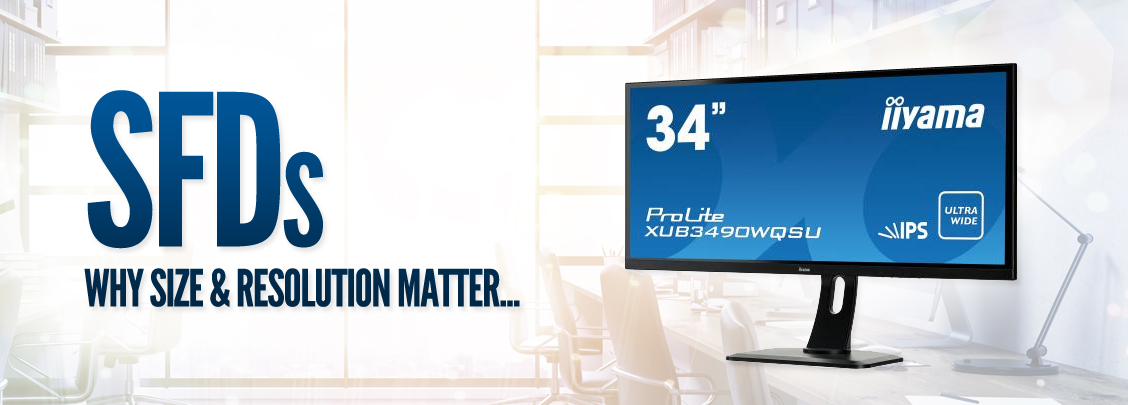Selecting small format displays – why buy bigger than a 22 inch?
When it comes to specifying solutions for your customers, making sure you’re delivering the most suitable option is as important as making sure the products are ready and waiting to ship.
Here, IIYAMA takes a look at Small Format Displays and why size – and resolution – really can make a difference.
Working across a broad array of verticals – from corporate and finance, through education, retail, transport and more – Small Format Displays (SFDs) offer excellent viewing with clear, clean images and bright colours.
SFDs can make a really big impact too, especially when choosing larger sizes – from 24” and 27” upwards – and models with higher resolutions.
So, what makes a good size for your Small Format Display?
In short, the bigger the screen size, the better your experience can be. Of course, much depends on the space your customers have earmarked for their display but, whether they’re using their SFDs for retail, in the corporate environment or for gaming, bigger can deliver improved picture quality, making more of high definition capabilities and delivering real visual impact.
Many people ask what difference just two inches can make to viewing quality, wondering why they should recommend a 22” screen or a larger, 24" or 27” equivalent. In particular, for sectors that require sharp image quality, such as the creative or medical sectors, when it comes to resolution and 4K or higher specifications, the bigger the screen size the better the effect from the increased number of pixels and enhanced picture quality.
It’s also important to note that for monitors under 27”, full HD is the better option – higher resolutions do not offer benefits on these screen sizes. As well as making the most of resolution capabilities.
Here are four things to consider when selecting the size of a small format display:
1. Usage – The way your customers intend to use their SFD and the software they’ll be using on it will play a big factor in the best-fit screen size for their work.
For office work, and if desk space is at a premium, a 22” to 24” SFD may be most suitable. However, for customers with a requirement for sharp image quality and detail, a 27” or 28” WQHD screen will give the best possible on-screen space, allowing them to run multiple applications simultaneously.
2. Desk space – In some industries desk space can be at a premium and, for those with smaller desks, smaller monitors will be required.
If your customer has a large desk, a bigger screen can offer better returns. Desktop monitors are generally available in sizes up to 32”. There are a few exceptions to this rule, though, including the IIYAMA XB3070QSU WQHD monitor with a 16:10 aspect ratio, the IIYAMA X3272UHS 4K display with an aspect ratio of 16:9, the IIYAMA XUB3490WQSU 34” WQHD ultra-wide screen with a 21:9 aspect ratio, and the IIYAMA X4071UHSU 40” 4K monitor with a 16:9 aspect ratio.
These larger sizes are also ideal for users who need a lot of desktop space, although, for these customers, a bigger screen size is not always the best answer. A dual monitor set-up that includes two full HD monitors, such as the IIYAMA XUB2492HSU-B1 24” monitor or the IIYAMA XUB2790HS-B1 27” equivalent, in combination with a dual monitor arm, IIYAMA DS3002C-B1, can be even more effective.
3. Aspect ratio – While aspect ratio is very much a personal preference, it does play a big role in obtaining the best image quality.
With this in mind, choosing the extra two inches offered by a 24” SFD can make a great difference, offering the near-perfect balance needed for 1080P on a 16:9 aspect ratio. The IIYAMA X2483HSU-B3 24” monitor offers a 16:9 aspect ratio together with true 1920 x 1080p resolution.
4. Budget – The size of screen your customer chooses may also come down to budget. If budget is your limiting factor, a 22”-24” desktop monitor with a HD resolution can work well for regular office work.
When your customers are working with spreadsheets or creative software and have a smaller desk, a 24” screen with full HD resolution, such as the IIYAMA XB2483HSU-B2 24”, will work well. For customers with a regular sized desk, though, a 25” or 27” full HD model, for instance the IIYAMA XU2590HS-B1 will also work perfectly.
As with any display, the screen size required for a SFD can be dependent on many factors – from usage requirements and viewing distance through to features and budget – and will, of course, be unique to each of your customers’ needs.
To find the most suitable size Small Format Display from IIYAMA for your customers, please view the range below or contact your Midwich account manager for more details.
